
Aberdyfi Castle is a castle located near Glandyfi, Ceredigion, in Wales. All that now remains is the motte, which is referred to as Domen Las (traditionally meaning "blue mound" in Welsh).

Aberdyfi Castle is a castle located near Glandyfi, Ceredigion, in Wales. All that now remains is the motte, which is referred to as Domen Las (traditionally meaning "blue mound" in Welsh).
Aberdyfi Castle was founded by the Lord Rhys, Rhys ap Gruffydd in 1156, shortly after he had become ruler of Deheubarth. Rhys had heard rumours that Owain Gwynedd was planning to invade Ceredigion in order to reclaim it for Gwynedd. Rhys responded by building a castle at Aberdyfi. However, the threatened invasion did not take place, and Turvey claims that Owain's intention may have been to test the resolve of the new ruler. Rhys "raised a ditch to give battle", according to Brut y Tywysogion , known as the 'Chronicles of the Princes' in English. [1]
Although the threat had not materialised, an earthwork topped by a timber castle was built on the site. A motte was constructed at the end of a low ridge running across marshy ground, surrounded on two sides by the confluence of the Dyfi and Einion rivers. The mound is still around 20 feet high with a diameter at the top of about 30 feet and it was originally surrounded by a deep ditch.
Roger de Clare, a Norman lord, attacked and captured the castle in about 1158. However, the Lord Rhys recaptured the castle the same year. Llywelyn the Great held an assembly at Aberdyfi Castle in 1216 where he supervised the parcelling-out of land in south Wales to the minor rulers of Deheubarth in return for their homage. Hitherto Llywelyn had ruled over Gwynedd only; however, the Aberdyfi assembly is seen as a crucial point in his reign, marking the moment at which the minor rulers of Wales submitted to Llywelyn's overlordship. In 1230 he began using the style 'prince of Aberffraw, lord of Snowdon' - in essence, a confirmation of his de facto position as prince of Wales. [2]
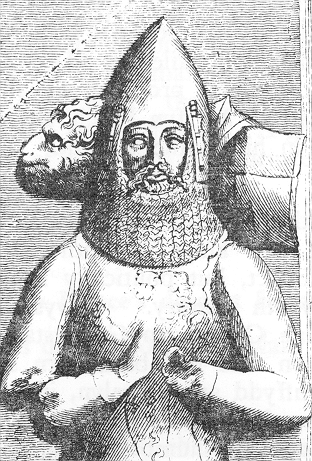
Rhys ap Gruffydd, commonly known as The Lord Rhys, in Welsh Yr Arglwydd Rhys was the ruler of the Welsh kingdom of Deheubarth in south Wales from 1155 to 1197 and native Prince of Wales.
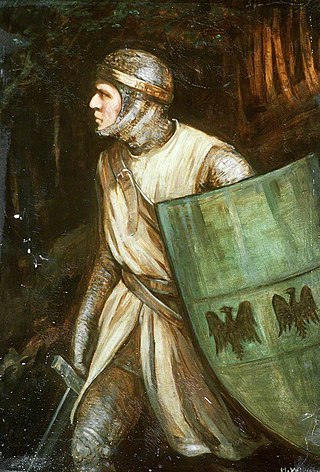
Owain ap Gruffudd was King of Gwynedd, North Wales, from 1137 until his death in 1170, succeeding his father Gruffudd ap Cynan. He was called Owain the Great and the first to be styled "Prince of Wales", and the "Prince of the Welsh". He is considered to be the most successful of all the North Welsh princes prior to his grandson, Llywelyn the Great. He became known as Owain Gwynedd to distinguish him from the contemporary king of Powys Wenwynwyn, Owain ap Gruffydd ap Maredudd, who became known as Owain Cyfeiliog.

Deheubarth was a regional name for the realms of south Wales, particularly as opposed to Gwynedd. It is now used as a shorthand for the various realms united under the House of Dinefwr, but that Deheubarth itself was not considered a proper kingdom on the model of Gwynedd, Powys, or Dyfed is shown by its rendering in Latin as dextralis pars or as Britonnes dexterales and not as a named land. In the oldest British writers, Deheubarth was used for all of modern Wales to distinguish it from Hen Ogledd, the northern lands whence Cunedda originated.

The Kingdom of Gwynedd was a Welsh kingdom and a Roman Empire successor state that emerged in sub-Roman Britain in the 5th century during the Anglo-Saxon settlement of Britain.
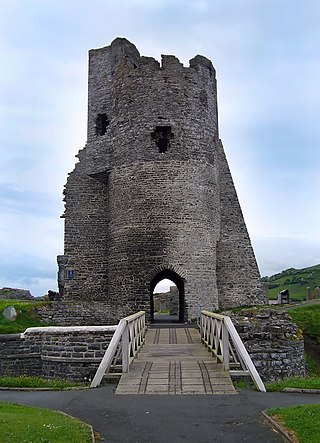
Aberystwyth Castle is a Grade I listed Edwardian fortress located in Aberystwyth, Ceredigion, Mid Wales. It was built in response to the First Welsh War in the late 13th century, replacing an earlier fortress located a mile to the south. During a national uprising by Owain Glyndŵr, the Welsh captured the castle in 1404, but it was recaptured by the English four years later. In 1637 it became a Royal mint by Charles I, and produced silver shillings. The castle was slighted by Oliver Cromwell in 1649.
Maelgwn ap Rhys was prince of part of the kingdom of Deheubarth in south west Wales.
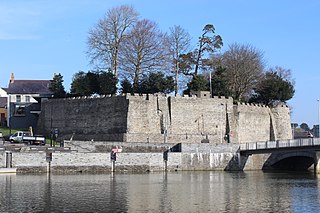
Cardigan Castle is a castle overlooking the River Teifi in Cardigan, Ceredigion, Wales. It is a Grade I listed building. The castle dates from the late 11th-century, though was rebuilt in 1244. Castle Green House was built inside the castle walls in the early 1800s. After falling into disrepair the castle was restored in the early 2000s and opened to the public in 2015. It is owned by Ceredigion County Council and now includes a heritage centre and open-air concert facilities. The castle's gardens are listed on the Cadw/ICOMOS Register of Parks and Gardens of Special Historic Interest in Wales.
Gwenllian ferch Gruffydd was Princess consort of Deheubarth in Wales, and married to Gruffydd ap Rhys, Prince of Deheubarth. Gwenllian was the daughter of Gruffudd ap Cynan (1055–1137), Prince of Gwynedd and Angharad ferch Owain, and a member of the princely Aberffraw family of Gwynedd. Gwenllian's "patriotic revolt" and subsequent death in battle at Kidwelly Castle contributed to the Great Revolt of 1136.
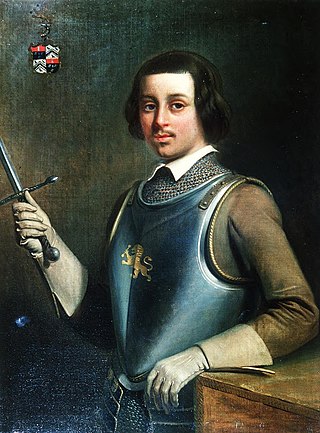
Rhys Gryg, real name Rhys ap Rhys, also known as Rhys Fychan, was a Welsh prince who ruled part of the Kingdom of Deheubarth.

The Royal House of Dinefwr was a cadet branch of the Royal House of Gwynedd, founded by King Cadell ap Rhodri, son of Rhodri the Great. Their ancestor, Cunedda Wledig, born in late Roman Britain, was a Sub-Roman warlord who founded the Kingdom of Gwynedd during the 5th century, following the Anglo-Saxon settlement of Britain. As Celtic Britons, the House of Dinefwr was ruling before the Norman conquest, having to fight with their neighbors such as the Celtics, Anglo-Saxons and Vikings, before struggling with the Normans afterwards. Many members of this family were influential in Welsh history, such as Hywel Dda, who codified Welsh law under his rule, and achieved the important title of King of the Britons, or Lord Rhys, Prince of Wales, who rebelled against Richard the Lionheart, and became one of the most powerful Welsh leaders of the Middle ages.
This article is about the particular significance of the century 1101–1200 to Wales and its people.
This article is about the particular significance of the century 1001–1100 to Wales and its people.

Wales in the High Middle Ages covers the 11th to 13th centuries in Welsh history. Beginning shortly before the Norman invasion of the 1060s and ending with the Conquest of Wales by Edward I between 1278 and 1283, it was a period of significant political, cultural and social change for the country.

Wales in the Middle Ages covers the history of the country that is now called Wales, from the departure of the Romans in the early fifth century to the annexation of Wales into the Kingdom of England in the early sixteenth century. This period of about 1,000 years saw the development of regional Welsh kingdoms, Celtic conflict with the Anglo-Saxons, reducing Celtic territories, and conflict between the Welsh and the Anglo-Normans from the 11th century.

The history of Gwynedd in the High Middle Ages is a period in the History of Wales spanning the 11th through the 13th centuries. Gwynedd, located in the north of Wales, eventually became the most dominant of Welsh polities during this period. Contact with continental courts allowed for Gwynedd to transition from a petty kingdom into an increasingly sophisticated principality of seasoned courtiers capable of high level deplomacy and representation; not only with the Angevine kings, but also the king of France and the Papal See. Distinctive achievements in Gwynedd include further development of Medieval Welsh literature, particularly poets known as the Beirdd y Tywysogion associated with the court of Gwynedd; the reformation of bardic schools; and the continued development of Cyfraith Hywel. All three of these further contributed to the development of a Welsh national identity in the face of Anglo-Norman encroachment of Wales.

The Royal House of Aberffraw was a cadet branch of the Kingdom of Gwynedd originating from the sons of Rhodri the Great in the 9th century. Establishing the Royal court of the Aberffraw Commote would begin a new location from which to rule Wales. The cadet branch achieved the recognised titles of Prince of Wales, King of Wales and were sometimes named King of Aberffraw.
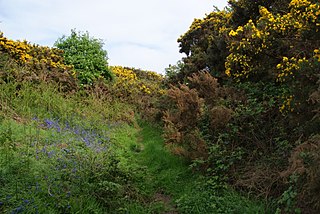
Castell Gwallter, also known as Walter's Castle and sometimes Castell Penweddig, is the remains of a Norman motte-and-bailey castle situated on a large hill above the old village of Llandre in northern Ceredigion, Wales, four miles northeast of Aberystwyth.
Angharad ferch Llywelyn was a daughter of Llywelyn ab Iorwerth, Prince of Wales. The identity of her mother is uncertain; but several later genealogical sources, including Pedigrees of Some Of the Emperor Charlemagne's Descendants, Volume III, compiled by J. Orton Buck and Timothy Field Beard, give Llywelyn's consort Joan, daughter of King John of England, as her mother.

Rhayader Castle is the remains of a motte-and-bailey castle in the town of Rhayader, Powys, Wales. The available documentary sources are not clear enough to distinguish between this site and the castle mound across the river and one or the other was probably built by Rhys ap Gruffydd, Prince of Deheubarth, in 1177. At that time the river formed the border between Gwrtheyrnion and the independent state of Buellt; the town of Rhayader is on the Gwrtheyrnion side of the river.